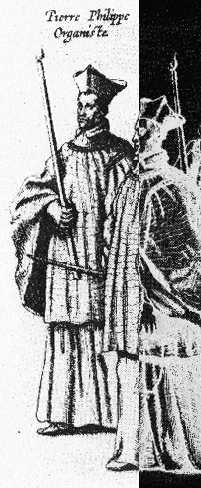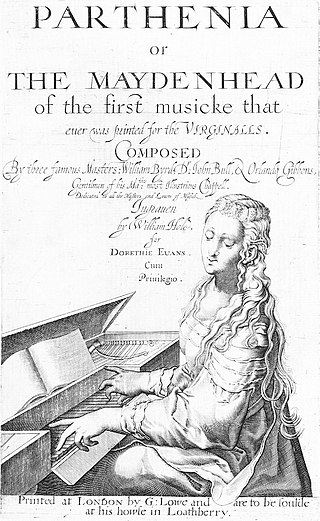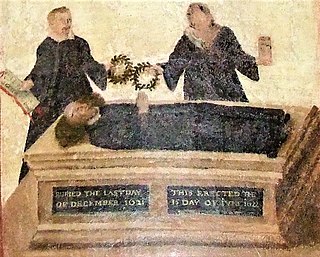
William Byrd was an English Renaissance composer. Considered among the greatest composers of the Renaissance, he had a profound influence on composers both from his native country and on the Continent. He is often considered along with John Dunstaple and Henry Purcell as one of England's most important composers of early music.

A spinet is a smaller type of harpsichord or other keyboard instrument, such as a piano or organ.

The virginals is a keyboard instrument of the harpsichord family. It was popular in Europe during the late Renaissance and early Baroque periods.

John Farmer was an important composer of the English Madrigal School. He was born in England during the Elizabethan period, and was also known by his skillful settings for four voices of the old church psalm tunes. His exact date of birth is not known – a 1926 article by Grattan Flood posits a date around 1564 to 1565 based on matriculation records. Farmer was under the patronage of the Earl of Oxford and dedicated his collection of canons and his late madrigal volume to his patron.

The Fitzwilliam Virginal Book is a primary source of keyboard music from the late Elizabethan and early Jacobean periods in England, i.e., the late Renaissance and very early Baroque. It takes its name from Viscount Fitzwilliam who bequeathed this manuscript collection to Cambridge University in 1816. It is now housed in the Fitzwilliam Museum at Cambridge. The word virginals does not necessarily denote any specific instrument and might refer to any instrument with a keyboard.

John Bull was an English composer, organist, virginalist and organ builder. He was a renowned keyboard performer of the virginalist school and most of his compositions were written for this medium.
Thomas Tomkins was a Welsh-born composer of the late Tudor and early Stuart period. In addition to being one of the prominent members of the English Madrigal School, he was a skilled composer of keyboard and consort music, and the last member of the English virginalist school.
Giles Farnaby was an English composer and virginalist whose music spans the transition from the Renaissance to the Baroque period.

During the reign of Queen Elizabeth I (1558–1603), English art and high culture reached a pinnacle known as the height of the English Renaissance. Elizabethan music experienced a shift in popularity from sacred to secular music and the rise of instrumental music. Professional musicians were employed by the Church of England, the nobility, and the rising middle-class.

Peter Philips was an eminent English composer, organist, and Catholic priest exiled to Flanders in the Spanish Netherlands. He was one of the greatest keyboard virtuosos of his time, and transcribed or arranged several Italian motets and madrigals by such composers as Lassus, Palestrina, and Giulio Caccini for his instruments. Some of his keyboard works are found in the Fitzwilliam Virginal Book. Philips also wrote many sacred choral works.

Parthenia or the Maydenhead of the first musicke that ever was printed for the Virginalls was, as the title states, the first printed collection of music for keyboard in England. 'Virginals' was a generic word at the time that covered all plucked keyboard instruments – the harpsichord, muselaar and virginals, but most of the pieces are also suited for the clavichord and chamber organ. Though the date is uncertain, it was probably published around 1612. The 21 pieces included are ascribed to William Byrd, John Bull, and Orlando Gibbons, in three sections.
John Mundy was an English composer, virginalist and organist of the Renaissance period.
Martin Peerson was an English composer, organist and virginalist. Despite Roman Catholic leanings at a time when it was illegal not to subscribe to Church of England beliefs and practices, he was highly esteemed for his musical abilities and held posts at St Paul's Cathedral and, it is believed, Westminster Abbey. His output included both sacred and secular music in forms such as consort music, keyboard pieces, madrigals and motets.
The Mulliner Book is a historically important musical commonplace book compiled probably between about 1545 and 1570, by Thomas Mulliner, about whom practically nothing is known, except that he figures in 1563 as modulator organorum (organist) of Corpus Christi College, Oxford. He is believed to have previously resided in London, where John Heywood inscribed the title page of the manuscript Sum liber thomas mullineri / iohanne heywoode teste.. A later annotation on the same page states that: T. Mulliner was Master of St Pauls school, but this has so far proved unsupportable. The provenance of the MS is unknown before it appears in the library of John Stafford Smith in 1776. After passing through the hands of Edward Francis Rimbault the MS was given to the British Museum in 1877 by William Hayman Cummings.
Blanche Winogron was an American harpsichordist, pianist, virginalist, and teacher.
"Will Yow Walke the Woods soe Wylde" is the title of a song from the Tudor era, popularly believed to have been a favourite of Henry VIII. The complete text of the song has not survived, but contained the short refrain:

Osbert Parsley was an English Renaissance composer and chorister. Few details of his life are known, but he evidently married in 1558, and lived for a period in the parish of St Saviour's Church, Norwich. A boy chorister at Norwich Cathedral, Parsley worked there throughout his musical career. He was first mentioned as a lay clerk, was appointed a "singing man" in c. 1534, and was probably the cathedral's unofficial organist for half a century. His career spanned the reigns of Henry VIII and all three of his children. After the Reformation of 1534, the lives of English church musicians changed according to the official policy of each monarch.

William Inglott or Inglot was an English organist and composer of the Elizabethan era, who is mostly associated with the cathedral in the English city of Norwich.
Benjamin Cosyn was an English composer, organist and virginalist. He was organist of St Laurence's Church, Ludlow, Dulwich College and Charterhouse School.

Margaret Henrietta Glyn was an English music historian specialising in Elizabethan keyboard music. A member of the family of Glyn baronets of Ewell, she benefited Ewell by her life and legacy.










